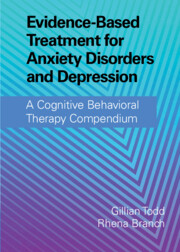 Evidence-Based Treatment for Anxiety Disorders and Depression
Evidence-Based Treatment for Anxiety Disorders and Depression Book contents
- Evidence-Based Treatment for Anxiety Disorders and Depression
- Evidence-Based Treatment for Anxiety Disorders and Depression
- Copyright page
- Contents
- Figures
- Tables
- Contributors
- 1 Introduction
- 2 The History and Philosophical Underpinnings of CBT:
- Part One Cognitive Behavioral Therapy for Anxiety Disorders
- Part Two Cognitive Behavioral Therapy for Posttraumatic Stress Disorder
- Part Three Cognitive Behavioral Therapy for Obsessive-Compulsive Disorder and Associated Disorders
- Part Four Cognitive Behavioral Therapy for Depression
- Part Five Complexity and Comorbidity in Anxiety Disorders and Depression:
- Part Six Specialist Applications of Cognitive Behavioral Therapy for Anxiety Disorders and Depression
- 24 The Application of CBT for Adults with Learning Disabilities
- 25 Cognitive Behavioral Therapy for Children and Adults with Autism
- 26 Adapting CBT for Treating Anxiety Disorders and Depression in Adults with ADHD
- 27 Adapting CBT for Children and Adolescents with Anxiety Disorders and Depression
- 28 Adapting Cognitive Behavioral Therapy for Older Adults with Anxiety Disorders and Depression
- 29 Cross-Cultural CBT
- Part Seven Future Developments
- Appendices
- Index
- References
25 - Cognitive Behavioral Therapy for Children and Adults with Autism
from Part Six - Specialist Applications of Cognitive Behavioral Therapy for Anxiety Disorders and Depression
Published online by Cambridge University Press: 06 January 2022
- Evidence-Based Treatment for Anxiety Disorders and Depression
- Evidence-Based Treatment for Anxiety Disorders and Depression
- Copyright page
- Contents
- Figures
- Tables
- Contributors
- 1 Introduction
- 2 The History and Philosophical Underpinnings of CBT:
- Part One Cognitive Behavioral Therapy for Anxiety Disorders
- Part Two Cognitive Behavioral Therapy for Posttraumatic Stress Disorder
- Part Three Cognitive Behavioral Therapy for Obsessive-Compulsive Disorder and Associated Disorders
- Part Four Cognitive Behavioral Therapy for Depression
- Part Five Complexity and Comorbidity in Anxiety Disorders and Depression:
- Part Six Specialist Applications of Cognitive Behavioral Therapy for Anxiety Disorders and Depression
- 24 The Application of CBT for Adults with Learning Disabilities
- 25 Cognitive Behavioral Therapy for Children and Adults with Autism
- 26 Adapting CBT for Treating Anxiety Disorders and Depression in Adults with ADHD
- 27 Adapting CBT for Children and Adolescents with Anxiety Disorders and Depression
- 28 Adapting Cognitive Behavioral Therapy for Older Adults with Anxiety Disorders and Depression
- 29 Cross-Cultural CBT
- Part Seven Future Developments
- Appendices
- Index
- References
Summary
Autistic children, adolescents, and adults face additional challenges, which means that for some, there may be an increased risk of developing mental health problems. These challenges can include difficulties with social skills and relationships, coping, rumination, executive functioning, inflexibility and tolerating uncertainty, sensory issues, and alexithymia. There is increasing evidence that cognitive-behavioral therapy can help with mental health problems when adapted appropriately to meet the needs of autistic children, adolescent, and adults. A variety of adaptions to cognitive-behavioral therapy for autistic people are presented and discussed within this chapter, which include changes to help with sensory issues, structures and routines, communication, social skills, emotions, circumscribed interests, cognitive and behavioral components of therapy, including psychoeducation and homework, as well as the inclusion of parents, family members, and carers within therapy.
- Type
- Chapter
- Information
- Evidence-Based Treatment for Anxiety Disorders and DepressionA Cognitive Behavioral Therapy Compendium, pp. 533 - 552Publisher: Cambridge University PressPrint publication year: 2022


